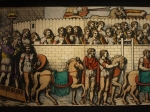The Lunt Hipposandal
Of all the finds from the Lunt dig which now reside in our cabinets – the HIPPOSANDAL has to be among the most intriguing.
In archaeological reports such objects are normally described as “temporary horseshoes”. That is exactly as our specimen is described in the Final Report of the Lunt excavations. On the face of it this seems a reasonable explanation. Yet there is far more to this question than meets the eye.
Why would the Roman cavalry need special “ temporary horseshoes”? Well, the obvious answer would seem to be that in the case of a thrown shoe a temporary replacement would be fitted by the rider. This, of course, presupposes the routine use of modern-style nailed on shoes by the Romans. Despite ample evidence to the contrary, there are those who will have us believe that the Romans knew nothing of such things. I think that “normal” horseshoes were widely used, especially in Northern Europe where soft, wet ground would often cause problems for unshod mounts. In more arid areas of the Empire horses may well have remained quite happily unshod. But I hear the cry “Where is the Evidence?” It is undeniable that finds of Roman horseshoes (and hipposandals!) are rare. Why? Because iron was a precious commodity, and all worn shoes would have been automatically melted down for re-use. A horseshoe is a difficult object to lose – unlike a coin!
So, if we entertain the existence of normal horseshoes in the Roman cavalry (particularly in units stationed in Britain) – then how can a hipposandal be used? You only have to glance at our hipposandal on display to realise that it is a somewhat curious contrivance. The hook apparently passes under the “heel” of the hoof, and the base-plate with its side-wings are somehow lashed to the fetlocks. It is very different to a nailed-on shoe. So different, in fact, that it seems unreasonable to expect any horse to run on three “nail-ons” and one hipposandal. Therefore, it would seem that hipposandals must have been used to shoe all four hooves.
However, there is a slight problem here. HORSES CANT WALK IN THEM. Well, they can – but they teeter along as if wearing high heels. And a reluctant, faltering walk is all you are going to get. Forget about trotting, let alone galloping!
We know this for a fact. Modern reconstructive experiments have conclusively shown that horses will not accept the hipposandal. Lets face it, they don’t look as if they are going to work. You don’t need to be a horse expert to sense that. So what on earth is going on? Why strap on a shoe that the horse cannot walk on?
I was discussing this question the other day with Dominic Russell, here at the fort. He made a very interesting point which deserves further consideration. Could the hipposandal be an intentional HOBBLING DEVICE?
Hobbling a horse simply means immobilising its legs – most simply achieved by tying them together. However, fitting a single hipposandal OVER a nail-on might possibly produce a very useful state of semi-mobility, meaning that a horse could graze if left for a protracted period, without wandering very far. Fitting two hipposandals would totally immobilise. Its easy to imagine tactical situations where either option might be useful.
The archaeological evidence at the Lunt points strongly to the deployment of a “Cohors Equitata” here. This implies a part-mounted cohort, composed, very roughly, of 300 light infantry auxilia and 200 cavalry. The way in which such a mixed force would have deployed in battle presents a good opportunity for a future blog, so without going any further into this question now – suffice it to say that battlefield tactics would have certainly covered scenarios where the cavalry were required to dismount, possibly moving off to support the infantry contingent. The horses, each hobbled with a single hipposandal, would not go far, and could be supervised by, perhaps, only one or two men. Not needing to detach men to hold horses would mean a 12.5% increase in the potential manpower available for “dragoon”-style tactics. This assumes that one trooper might hold eight horses – though more men would be needed if the mounts were excited or frightened.
Its certainly a beguiling idea – but the “tactical hobbling” theory has one nasty fly in the ointment. A cavalryman, operating as a dragoon, needs to be able to dismount, secure his horse in some manner, and move quickly on foot to his battle position. But even more importantly, he needs to be able to RETRIEVE his mount with the utmost speed. His life may regularly depend on this ability. A soldier holding the horses is certainly the most effective means of quick release for each mount as its rider returns. The reins are passed, the rider vaults into his saddle (no stirrups!) – and away! In contrast, a trooper racing back to his hipposandalled mount will have to stop……and fiddle for agonising moments. It has to be quick and easy. Are there straps with quick release buckles? Lets hope so – because there certainly isn’t going to be time to start untying knots! Or does he cut the straps or thongs? Whichever way – vital time is disappearing.
It’s a pity that the whole business of re-mounting rather spoils a neat theory explaining the purpose of the hipposandal. To me, at least, it remains inexplicable.
Anyone got any thoughts on this? Rob
P.S. “Hippo” Greek for Horse (nothing to do with dancing hippopotami – that was Walt Disney)







